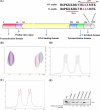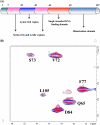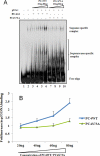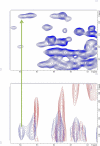Peptide-protein interactions suggest that acetylation of lysines 381 and 382 of p53 is important for positive coactivator 4-p53 interaction
- PMID: 21586571
- PMCID: PMC3137081
- DOI: 10.1074/jbc.M110.205328
Peptide-protein interactions suggest that acetylation of lysines 381 and 382 of p53 is important for positive coactivator 4-p53 interaction
Abstract
The human transcriptional positive coactivator 4 (PC4) activates several p53-dependent genes. It has been demonstrated that this is a consequence of direct interaction with p53. Previously, we have concluded that PC4 interacts mainly with the C-terminal negative regulatory domain of p53 through its DNA binding C-terminal half. NMR chemical shift perturbation studies with peptide fragments indicated that amino acids 380-386 of p53 are crucial for interaction with PC4. This was verified by fluorescence anisotropy and sedimentation velocity studies. A peptide consisting of p53-(380-386) sequence, when attached to a cell penetration tag and nuclear localization signal, localizes to the nucleus and inhibits luciferase gene expression from a transfected plasmid carrying a Luc gene under a p53-dependent promoter. Acetylation of lysine 382/381 enhanced the binding of this peptide to PC4 by about an order of magnitude. NMR and mutagenesis studies indicated that serine 73 of PC4 is an important residue for recognition of p53. Intermolecular nuclear Overhauser effect placed aspartate 76 in the vicinity of lysine 381, indicating that the region around residues 73-76 of PC4 is important for p53 recognition. We conclude that the 380-386 region of p53 interacts with the region around residues 73-76 of PC4, and acetylation of lysine 382/381 of p53 may play an important role in modulating p53-PC4 interaction and as a consequence PC4 mediated activation of p53 target genes.
Figures









Similar articles
-
Insights on the disruption of the complex between human positive coactivator 4 and p53 by small molecules.Biochem Biophys Res Commun. 2021 Nov 12;578:15-20. doi: 10.1016/j.bbrc.2021.09.020. Epub 2021 Sep 10. Biochem Biophys Res Commun. 2021. PMID: 34534740
-
Gradual phosphorylation regulates PC4 coactivator function.FEBS J. 2006 Apr;273(7):1430-44. doi: 10.1111/j.1742-4658.2006.05165.x. FEBS J. 2006. PMID: 16689930
-
Activation of p53 function by human transcriptional coactivator PC4: role of protein-protein interaction, DNA bending, and posttranslational modifications.Mol Cell Biol. 2007 Nov;27(21):7603-14. doi: 10.1128/MCB.01064-07. Epub 2007 Sep 4. Mol Cell Biol. 2007. PMID: 17785449 Free PMC article.
-
Lysine-specific modifications of p53: a matter of life and death?Oncotarget. 2013 Oct;4(10):1556-71. doi: 10.18632/oncotarget.1436. Oncotarget. 2013. PMID: 24298606 Free PMC article. Review.
-
Structural biology of the p53 tumour suppressor.Curr Opin Struct Biol. 2009 Apr;19(2):197-202. doi: 10.1016/j.sbi.2009.02.003. Epub 2009 Mar 13. Curr Opin Struct Biol. 2009. PMID: 19286366 Review.
Cited by
-
p53 N-terminal phosphorylation: a defining layer of complex regulation.Carcinogenesis. 2012 Aug;33(8):1441-9. doi: 10.1093/carcin/bgs145. Epub 2012 Apr 12. Carcinogenesis. 2012. PMID: 22505655 Free PMC article. Review.
-
Regulation of metabolism by mitochondrial enzyme acetylation in cardiac ischemia-reperfusion injury.Biochim Biophys Acta Mol Basis Dis. 2020 Jun 1;1866(6):165728. doi: 10.1016/j.bbadis.2020.165728. Epub 2020 Feb 15. Biochim Biophys Acta Mol Basis Dis. 2020. PMID: 32068115 Free PMC article. Review.
-
Human PC4 supports telomere stability and viability in cells utilizing the alternative lengthening of telomeres mechanism.EMBO Rep. 2024 Dec;25(12):5294-5315. doi: 10.1038/s44319-024-00295-3. Epub 2024 Oct 28. EMBO Rep. 2024. PMID: 39468351 Free PMC article.
-
Mutant TP53 posttranslational modifications: challenges and opportunities.Hum Mutat. 2014 Jun;35(6):738-55. doi: 10.1002/humu.22506. Epub 2014 Feb 11. Hum Mutat. 2014. PMID: 24395704 Free PMC article. Review.
-
An acetyl-methyl switch drives a conformational change in p53.Structure. 2015 Feb 3;23(2):322-31. doi: 10.1016/j.str.2014.12.010. Structure. 2015. PMID: 25651062 Free PMC article.
References
-
- Momand J., Zambetti G. P., Olson D. C., George D., Levine A. J. (1992) Cell 69, 1237–1245 - PubMed
-
- Dornan D., Wertz I., Shimizu H., Arnott D., Frantz G. D., Dowd P., O'Rourke K., Koeppen H., Dixit V. M. (2004) Nature 429, 86–92 - PubMed
-
- Leng R. P., Lin Y., Ma W., Wu H., Lemmers B., Chung S., Parant J. M., Lozano G., Hakem R., Benchimol S. (2003) Cell 112, 779–791 - PubMed
-
- Haupt Y., Maya R., Kazaz A., Oren M. (1997) Nature 387, 296–299 - PubMed
Publication types
MeSH terms
Substances
LinkOut - more resources
Full Text Sources
Molecular Biology Databases
Research Materials
Miscellaneous

